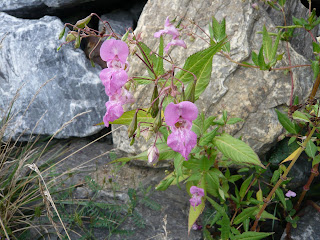Since I can see the waypoints visible on the screen of the GPS, Andy and I decide he will take the lead. He has a great sense of direction. I’ll give verbal queues from behind as the waypoints come closer into range according to the GPS. There are a couple of bridges that will take one over the Fore River, and of course we learn later that we’ve taken the one furthest off our course. No matter, we are in no rush, but it would be nice to find these lighthouses a bit easier. As we ride along, it seems wise to make our way to the furthest one first, because the road signs are now pointing us in that direction.
We arrive at Cape Elizabeth. We pull into a parking lot at the end of Two Lights Road, as there is no on site access to this light. This is a beautiful setting however, and the lighthouse itself is picturesque. A painting of this lighthouse by Edward Hopper was featured on a 1970 US postage stamp, and I can understand why. It has a prominence and quiet majesty about it that leads one to linger at this spot. Andy and I walk the breakwater past the massive fog horn stationed there. The signs here warn of its loud blast that can be unexpected and ear piercing. I have no worry as fortunately, this day is without fog.


We set off again with Andy in the lead. Over the radio he asks what I’m seeing on the GPS screen. I tell him he needs to find his way to the right somehow. He does, and takes us through a beautiful community that warns us there is “no thru traffic” this way. I can see why. Money talks and the homes along this stretch of road are something to behold. I could house Andy’s and my family in any one of them. With Andy’s eleven siblings and my own seven, that is saying something about these homes. The route is great though as it leads us directly to our next destination, Portland Head Lighthouse on the site adjoining Fort Williams Park, Cape Elizabeth. If I thought Cape Elizabeth Lighthouse was picturesque, it paled in comparison to the Portland Head. Consulting my lighthouse guide, I read that this is the most photographed lighthouse in North America. There is no argument from me. As an added bonus Ram Island Ledge lighthouse is visible from shore.



Finding the last two lighthouses in Portland are tricky. We can’t seem to find any direct route, there are no street signs pointing the way, and the area seems busy with commercial shipping and recreational boating. Finally we spy from the road the top of one, yet we can’t get to it. Andy continues on, and we find the other, the Portland Breakwater Light. This light is also affectionately referred to by the locals that the Bug Light. There is a pleasant park here also called Bug Light Park, with a memorial to the shipbuilders that worked in this area. The plaques are worth reading and I found it interesting that there are 60 positions for which you could apply for to work to build a ship. It reminded me of the mill days when my relatives worked the looms in the Amoskeag Mills, or in the shoe shops that once were prevalent in the Manchester NH area. I myself had a summer job as a stitcher and my specific job was the “vamp.”




From Bug Light Park we can see the last of our Portland area lighthouses, the Spring Point Ledge and scratch our heads on how to reach this light. I remember then that the access to this light is trough the parking lot of the Southern Maine Community College campus. We have passed the college on the way to Bug Light, so we backtrack and then proceed through the campus. Sure enough, we are lead directly to the lighthouse. This lighthouse is at the end of a 900’ long breakwater constructed with 50,000 tons of irregular granite blocks quarried from Biddeford and Wells Maine. At the end of the breakwater at the base of the light are two panels of solar cells which now power the automated light. We spend some time in the wind watching vessels of all sizes pass by. Since it is now close to 2:00 pm we decide it’s time for lunch and make our way to the nearby Joe’s Boathouse and have a pleasant meal on the deck overlooking Casco Bay.




We look at our watches and decide we have time for the last lighthouse on our tour, the Cape Neddick Lighthouse or “the Nubble” as the lofty prominence of land a few hundred feet offshore is called by the locals. This lighthouse has no onsite views as the channel separates it from the parking where we now find ourselves. We linger here for a bit and take time to soak our feet in the ocean water as the day is quiet hot. We chuckle that with the expanse of ocean we have seen this week, it is the first time we dip any part of our body into ocean water. A look at our watches tells us it is past five o’clock, and decide that it’s time to high tail it to the Hotel Henderson. With that, for the first time this week, we make for the interstate and head for home. It is on this high speed, wind refreshing blast for New Hampshire, that I realize why the GPS has pointed us to ferry landings. It is human error in that I had forgotten to set this as one of the avoidances in the settings. Hopefully, it’s not too late for others to learn from my mistake should you choose to take the Lighthouse Tour for yourselves.

















































